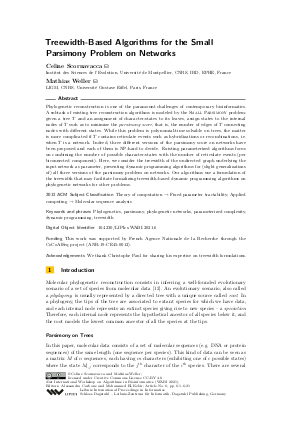@InProceedings{scornavacca_et_al:LIPIcs.WABI.2021.6,
author = {Scornavacca, Celine and Weller, Mathias},
title = {{Treewidth-Based Algorithms for the Small Parsimony Problem on Networks}},
booktitle = {21st International Workshop on Algorithms in Bioinformatics (WABI 2021)},
pages = {6:1--6:21},
series = {Leibniz International Proceedings in Informatics (LIPIcs)},
ISBN = {978-3-95977-200-6},
ISSN = {1868-8969},
year = {2021},
volume = {201},
editor = {Carbone, Alessandra and El-Kebir, Mohammed},
publisher = {Schloss Dagstuhl -- Leibniz-Zentrum f{\"u}r Informatik},
address = {Dagstuhl, Germany},
URL = {https://drops.dagstuhl.de/entities/document/10.4230/LIPIcs.WABI.2021.6},
URN = {urn:nbn:de:0030-drops-143591},
doi = {10.4230/LIPIcs.WABI.2021.6},
annote = {Keywords: Phylogenetics, parsimony, phylogenetic networks, parameterized complexity, dynamic programming, treewidth}
}

 Creative Commons Attribution 4.0 International license
Creative Commons Attribution 4.0 International license





























